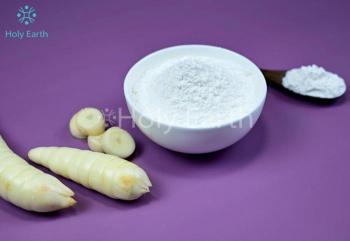
Arrowroot is an organic gluten-free plant-based product. Therefore it comes with a high shelf life. If arrowroot powder is stored in an airtight container in a cool and dry place, it can last 3 to 4 years. So, you can purchase arrowroot powder in bulk, and store it in containers with tight-fitting lids. Unlike cornstarch, arrowroot does freeze and thaw without change. It has a more neutral taste; it doesn't taste “starchy” like other grain starches. If you want, you can also refrigerate in an air-tight container for optimal freshness.
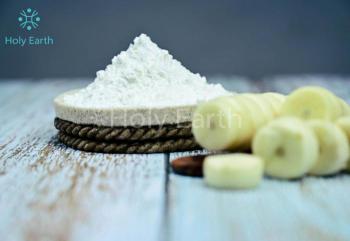
Arrowroot powder is enormously versatile. It can be extensively used as a thickener, can be blended with other flours such as almond flour, coconut flour, and tapioca flour for baking as well as for bread and dessert recipes.
It can be used as a thickener in sauces, stews, gravies, soups, pancakes, and pie fillings. It is the best thickening agent in dishes with acid ingredients like hot and sour soup or cranberry sauce. It can be used as a coating for frying fish and meat. Arrowroot can be a great option for coating substances before frying them as well. It makes things crispy or crunchy. You could coat sweet potato fries in a dusting of arrowroot to make them crispier. You could also mix arrowroot powder with a blend of dried herbs to coat chicken before frying. It can be used as a coating for frying fish, meat, potatoes, sweet potatoes, bitter gourd, and many other vegetables to make them crispier. However, it turns slimy when mixed with milk products. Therefore it is best to avoid arrowroot with dairy products. To use arrowroot in puddings and custard is definitely not a good idea. Keep in mind these few things before using arrowroot powder as a thickener:
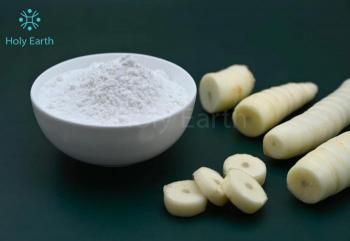
Arrowroot can be a good gluten-free substitute for all-purpose flour, especially as a thickener as it has twice the thickening capacity compared to the all-purpose flour. With acidic ingredients, arrowroot powder is the best. In the case of baking, arrowroot can replace all-purpose flour but it is used in smaller amounts and that too in combination with other gluten-free flours, as the starch amount is too high in arrowroot. Unlike flour, arrowroot doesn’t make the dishes cloudy and opaque. Arrowroot is a starchy substance, extracted from the root of a tropical plant known as Maranta arundinacea. When harvested, it looks like typical oblong-shaped underground tubers like cassava, yucca, or kudzu. It is a great substitute because unlike cornstarch the starch of Arrowroot powder is extracted in simpler, more traditional methods without using high heat or harsh chemicals. Arrowroot powder is enormously versatile. It can be extensively used as a thickener, can be blended with other flours such as almond flour, coconut flour, and tapioca flour for baking as well as for bread and dessert recipes.
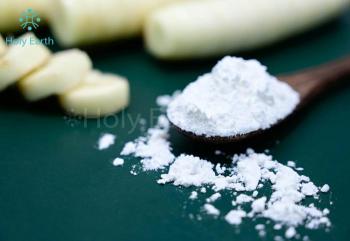
Similar to tapioca flour. Arrowroot is a flavorless, gluten-free flour. It is made from the Maranta arundinacea plant. Arrowroot flour can be a good substitute for tapioca flour as a thickening agent in highly acidic dishes. It is used in a 1:1 ratio in most dishes. But it cannot be used as a replacement in baking dishes where tapioca is generally used as starch. However, it lacks the chewy consistency of tapioca. So, when used as a stand-alone flour, it doesn’t create the same chewy consistency as tapioca. Thus, arrowroot will not make a good replacement unless it’s used alongside a combination of other flours. Similarly, in dairy-related dishes arrowroot cannot replace tapioca.
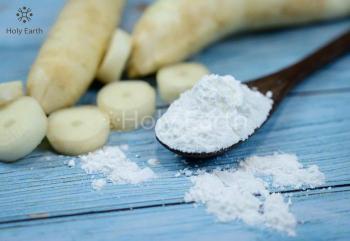
People generally confuse arrowroot flour with tapioca and use the names arrowroot flour and tapioca flour interchangeably in many places but they are not the same. They are obtained from root vegetables of different plants. Arrowroot starch is procured from the Maranta arundinacea plant whereas tapioca is produced from cassava root. They both are gluten-free and are used as thickeners in food. Arrowroot combines well with acidic ingredients while tapioca is not recommended with highly acidic food. On the other hand, tapioca works well in milk-based recipes whereas arrowroot is generally avoided in dairy-based recipes. In baking, Arrowroot can be used in smaller amounts, combined with another gluten-free flour like almond flour. It’s too starchy to use on its own. It can also be used as a thickener in the same way tapioca starch can be. Tapioca starch can be an excellent substitution for arrowroot powder for a thickener as tapioca starch will work in the same fashion.
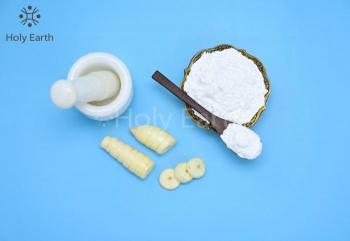
Arrowroot is a healthier alternative to cornstarch as it contains more dietary fibers than cornstarch. Arrowroot is richer in minerals like calcium and potassium. It has a good amount of folate that helps in RBC formation. It is also processed from non-GMO plants whereas most corn starch available in the market are highly processed foods produced from GMO plants. Both arrowroot and cornflour are starch used as thickening agents. But they come from two different sources. Arrowroot flour belongs to the root starch category. Whereas cornstarch falls under the grain starch category. Cornstarch is the traditional thickener used in cooking for a long time. But, several unique properties of arrowroot powder make it a healthier alternative to Cornstarch. It is gluten-free and is naturally GMO-free. Arrowroot powder gives a glossy texture and a silky feel in contrast to the cloudy and opaque appearance of sauces made with cornstarch. In addition, it is easily digestible and an ideal alternative for cornstarch in sauces that have acidic ingredients or products that need to be frozen. Arrowroot is simply a white, powdery starch that's naturally gluten-free, grain-free, vegan, and paleo-friendly. Potassium, iron, zinc, copper, magnesium, and Vitamin B complex in arrowroot improve the lymphatic system and stimulate the immune cells. Arrowroot is highly rich in Vitamin C, which is very beneficial to the immune system. Altogether, arrowroot is a prebiotic starchy food that is high in dietary fiber and has a good response to the immune system. A 1-cup (120-gram) serving of sliced, raw arrowroot contains the following:

Arrowroot is a starchy substance, extracted from the root of a tropical plant known as Maranta arundinacea. When harvested, it looks like typical oblong-shaped underground tubers like cassava, yucca, or kudzu. It is a great substitute because unlike cornstarch the starch of Arrowroot powder is extracted in simpler, more traditional methods without using high heat or harsh chemicals. Arrowroot powder is known as arrowroot flour or arrowroot starch. They’re all the same thing. This simple powdery white starch is naturally gluten-free, grain-free, vegan, and paleo-friendly. But keep in mind, even though arrowroot flour or arrowroot starch is almost the same thing; the sauce won't end up with the same glossy finish that arrowroot powder gives. Best to use 2 tbsp of all-purpose flour for every 1 tbsp of arrowroot powder in a recipe.

Arrowroot flour is a white, powdery, gluten-free starch produced from the tuber of arrowroot plants. Obtained from the rhizomes of a tuber crop Maranta arundinacea, Arrowroot is a large perennial herb found in tropical forests. It is an unconventional source of starch having tremendous potential in the food, cosmetics, and pharmaceutical industries. It is a large perennial herb that may vary in length from 3 to 6 feet with large-sized stems and turmeric-like broad ovate leaves. Flowers are tiny, white in color, and appear all along the long pedicle about 90 days after planting. Arrowroot leaves are called lanceolate. The root is underground and is about 10 inches long, weighing about 30 to 50 g. The root is a small, cylindrical-shaped, cream-white/light red tuber, covered with thin surface scales similar to cassava and yucca or kudzu which are oblong in shape. The root parts of the plant are typically called arrowroot and are edible. It is mostly starchy and can be used rather like a potato. It is a cream-white cylindrical-shaped tuber and carries a resemblance to a large potato covered with thin surface scales. Just like corn starch, it has thickening abilities. In raw form, it is ivory to white in color and is firm, dense, and smooth in touch, and juicy in taste with a mild, sweet flavor. It is also grain-free and vegan flour that is used as a thickening agent in sauces, soups, puddings, and pie fillings.
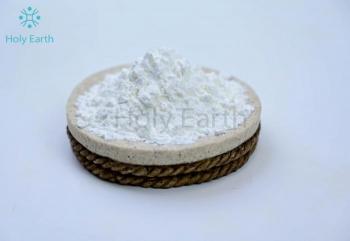
Arrowroot refers to the easily digested starch obtained from the rhizomes of a tuber crop Maranta arundinacea, which is a large perennial herb found in tropical forests. It is an unconventional source of starch having tremendous potential in the food, cosmetics, and pharmaceutical industries. It is a large perennial herb that may vary in length from 3 to 6 feet with large-sized stems and turmeric-like broad ovate leaves. Flowers are tiny, white in color, and appear all along the long pedicle about 90 days after planting. Arrowroot leaves are called lanceolate. The root is underground and is about 10 inches long, weighing about 30 to 50 g. The root is a small, cylindrical-shaped, cream-white/light red tuber, covered with thin surface scales similar to cassava and yucca or kudzu which are oblong in shape. The root parts of the plant are typically called arrowroot and are edible. It is mostly starchy and can be used rather like a potato. It is a cream-white cylindrical-shaped tuber and carries a resemblance to a large potato covered with thin surface scales. Just like corn starch, it has thickening abilities. In raw form, it is ivory to white in color and is firm, dense, and smooth in touch, and juicy in taste with a mild, sweet flavor. Arrowroot is a great substitute for cornstarch and can be used in cooking, baking, and as a thickener in sauces, soups, puddings, and pie fillings. Arrowroot powder is generally available in grocery stores in the gluten-free section or in health food stores. Natural food stores or health food stores often carry arrowroot powder. Just look near flour, grains, or baking supplies, or in the gluten-free specialty section in the market. It can also be purchased from online vendors. Arrowroot is simply a white, powdery starch that's naturally gluten-free, grain-free, vegan, and paleo-friendly. Potassium, iron, zinc, copper, magnesium, and Vitamin B complex in arrowroot improve the lymphatic system and stimulate the immune cells. Arrowroot is highly rich in Vitamin C, which is very beneficial to the immune system. It is a probiotic starchy food that is high in dietary fiber and has a good response to the immune system. A 1-cup (120-gram) serving of sliced, raw arrowroot contains the following:
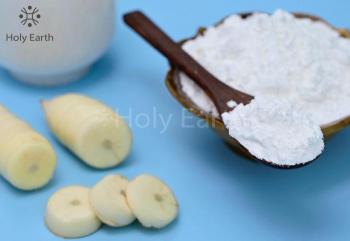
Arrowroot powder is enormously versatile. It can be extensively used as a thickener, can be blended with other flours such as almond flour, coconut flour, and tapioca flour for baking as well as for bread and dessert recipes. Arrowroot powder is an excellent thickener used in stews, soups, gravies, and sauces. Stew can be thickened by first making arrowroot slurry in which arrowroot powder is mixed in cold water and the slurry is added to the hot stew or gravy at the end of the cooking to thicken it without changing the color and texture of the stew. Just like most gluten-free and paleo flours, arrowroot powder isn’t typically used on a 1:1 ratio of its replacement. If you’re substituting arrowroot with cornstarch, best to start with 1/3 to 1/2 the amount of cornstarch required. Be careful not to add too much arrowroot to a sauce, as the result can turn into a gloppy, jelly mess. Keep in mind these two things before using arrowroot powder as a thickener:

Arrowroot powder is enormously versatile. It can be extensively used as a thickener, can be blended with other flours such as almond flour, coconut flour, and tapioca flour for baking as well as for bread and dessert recipes. Arrowroot powder can be used in any pie filling as a substitute for cornstarch. It normally creates a glossy texture and a silky mouthfeel. However, it turns slimy when mixed with milk products. Therefore it is best to avoid arrowroot with dairy products. To use arrowroot in puddings and custard is definitely not a good idea. Keep in mind these two things before using arrowroot powder as a thickener:
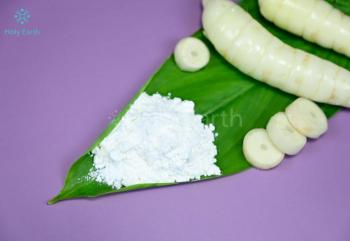
Arrowroot powder is enormously versatile. It can be extensively used as a thickener, can be blended with other flours such as almond flour, coconut flour, and tapioca flour for baking as well as for bread and dessert recipes. Substituting almond flour in recipes as an all-purpose flour substitute can be tough. Almond flour has a higher moisture content than wheat flour, so you have to use a larger quantity of it in order to offset that. When substituting, a general rule of thumb is a 1:2 ratio of regular flour to almond flour. Be aware that some recipes may require some trial and error before finding the right amount. It generally gives bread, muffins, and other bakery products a moist and tender texture. So arrowroot flour cannot generally replace almond flour but can be used in combination with almond flour in the bakery. Arrowroot can be used in baking. But it is too starchy on its own. So it's typically used in smaller amounts, combined with other gluten-free flours. Another trick for this can be to combine arrowroot flour with a drier alternative flour like coconut flour to get the right moisture level. If you are looking for an almond flour substitute, best to focus on other nut flours like pecan, macadamia, or cashew flour as they will have a similar profile and will respond similarly when baking.
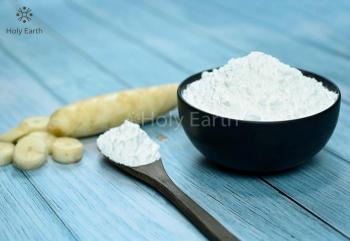
Arrowroot is a healthier alternative to cornstarch as it contains more dietary fibers than cornstarch. Arrowroot is richer in minerals like calcium and potassium. It has a good amount of folate that helps in RBC formation. It is also processed from non-GMO plants whereas most corn starch available in the market are highly processed foods produced from GMO plants. Both arrowroot and cornflour are starch used as thickening agents. But they come from two different sources. Arrowroot flour belongs to the root starch category. Whereas cornstarch falls under the grain starch category. Cornstarch is the traditional thickener used in cooking for a long time. But, several unique properties of arrowroot powder make it a healthier alternative to Cornstarch. It is gluten-free and is naturally GMO-free. Arrowroot powder gives a glossy texture and a silky feel in contrast to the cloudy and opaque appearance of sauces made with cornstarch. In addition, it is easily digestible and an ideal alternative for cornstarch in sauces that have acidic ingredients or products that need to be frozen. Arrowroot is simply a white, powdery starch that's naturally gluten-free, grain-free, vegan, and paleo-friendly. Potassium, iron, zinc, copper, magnesium, and Vitamin B complex in arrowroot improve the lymphatic system and stimulate the immune cells. Arrowroot is highly rich in Vitamin C, which is very beneficial to the immune system. Altogether, arrowroot is a prebiotic starchy food that is high in dietary fiber and has a good response to the immune system. A 1-cup (120-gram) serving of sliced, raw arrowroot contains the following:
Calories: 78
Carbs: 16 grams
Protein: 5 grams
Fiber: 2 grams
Fat: 0 grams
Phosphorus: 17% of the DV
Iron: 15% of the DV
Folate: 102% of the Daily Value (DV)
Potassium: 11% of the DV
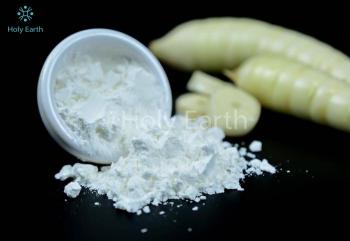
Arrowroot is one of the natural ways to starch clothes at home. Arrowroot, a tropical plant, can also be used in combination with chemically treated starch. In about 2 cups of water, 1 ½ teaspoon of arrowroot powder can be added along with a small amount of flour. The solution needs to be mixed properly followed by soaking the desired clothes in the solution to starch the clothes. Finally, leave the clothes to dry. You can even make Homemade Spray Starch using arrowroot.
Mix all ingredients into a spray bottle, shake it well, and voila, your spray scratch is ready. You can now spray this solution over your fabric to get a stiff and permanent result. It’s always best to spray the back of your fabric, just in case to avoid visible residue on the fabric.
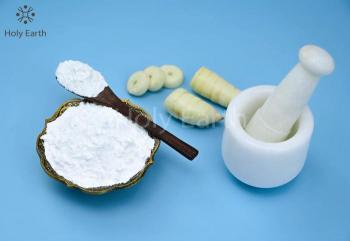
Arrowroot can make fries crispy and crunchy. Arrowroot powder is enormously versatile. It can be extensively used as a thickener, can be blended with other flours such as almond flour, coconut flour, and tapioca flour for baking as well as for bread and dessert recipes. Arrowroot can be a great option for coating substances before frying them as well. It makes things crispy or crunchy. You could coat sweet potato fries in a dusting of arrowroot to make them crispier. You could also mix arrowroot powder with a blend of dried herbs to coat chicken before frying. It can be used as a coating for frying fish, meat, potatoes, sweet potatoes, bitter gourd, and many other vegetables to make them crispier.

Arrowroot is a starch obtained from the rhizome of a tuber crop Maranta arundinacea. It can be eaten raw, boiled, roasted, stewed, or as a coating for frying. A 1-cup (120-gram) of sliced, raw arrowroot contains the following
The whole root can be used in recipes too. The papery layer should be peeled off before the root is boiled or fried. It can also be prepaid into chips, flavored with salt and spices. Although the root of the plant can be cooked directly, arrowroot is mainly consumed as a powder.
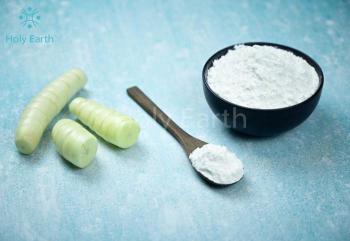
One of the biggest advantages of Arrowroot powder is that it can be eaten during the fasting days as cornstarch cannot be eaten during these days. Arrowroot is purely Vegan and gluten-free. However, it also depends on your culture, rituals, and region-specific dietary preferences whether you are allowed to consume arrowroot. If you’re fasting because of a medical / lifestyle intervention to lose weight then the key would be to avoid insulin spikes. You would aim to get your body back to homeostasis in order to bring down your elevated insulin levels back down to baseline. So that fat burning can be triggered. Any Carb (starch) would cause insulin spikes thereby defeating the purpose of the fast. Though arrowroot is high in carbs and rich in fibers the ideal quantity should not exceed more than 10 grams during the fast. And as far as religious customs go, arrowroot has been popularly used to prepare fasting recipes. Some of the most common fasting recipes that use arrowroot flour are Khandvi and Farali Pattice. The whole root can be used in recipes too.
Basically a native to West Indies (St. Vincent and Jamaica), Australia, Southeast Asia, Central America, South America, and South and East Africa, the arrowroot plant is now grown in tropical regions all over the world. The cultivation of arrowroot began 7000 years ago. This indigenous crop is said to have originated from South Africa. This perennial herb grows up to 3 to 5 feet in height with broad, flat, oval-shaped leaves like turmeric. Its name comes from the Caribbean Arawak language; aru-aru which means ‘meal of meals’. The Caribbeans used it as their staple food in their cooking. Because arrowroot has the potential to draw out the poison when applied to the injury site, some literature also suggests that name comes from arrowroot’s ability in treating poison - arrow wounds. West Indian arrowroot, West Indian reed, Arrowroot Plant, True arrowroot, St. Vincent arrowroot, Maranta, Obedience plant Bermuda arrowroot are also some other popular common names of this indigenous plant. In the Indian subcontinent, Arrowroot goes by the name Sita Tavakshira in Sanskrit, Palagunda in Telugu, Ararutkilangu in Tamil, Kua, Ararut-kizhangu, Koova in Malayalam, Ararut-gaddalu, Koove-hittu in Kannada, Tavakria in Marathi, Ararut, Jakhur, Jukhur in Bengali, and Araaruta in Hindi, Oriya, and Punjabi.
The arrowroot plant is a tropical plant called Maranta arundinacea. It is a large perennial herb that may vary in length from 3 to 6 feet with large-sized stems and turmeric-like broad ovate leaves. Flowers are tiny, white in color, and appear all along the long pedicle about 90 days after planting. Arrowroot leaves are called lanceolate. The root is underground and is about 10 inches long, weighing about 30 to 50 g. The root is a small, cylindrical-shaped, cream-white/light red tuber, covered with thin surface scales similar to cassava and yucca or kudzu. Basically, it looks like a large potato covered with thin surface scales. The root parts of the plant are typically called arrowroot and are edible. It is mostly starchy and can be used rather like a potato. In raw form, it is ivory to white in color and is firm, dense, and smooth in touch, and juicy in taste with a mild, sweet flavor. However, the leaves and stalks of the plant can also be chopped up and used as surface mulch around the garden. The artwork will utilize it to help cycle minerals deep into the soil.
Arrowroot powder is an excellent thickener used in stews, soups, gravies, and sauces where it adds texture and structure. Though both arrowroot and cornflour are starch and are used as thickening agents, several unique properties of arrowroot powder make it a healthier alternative to cornstarch. It is gluten-free and is naturally GMO-free. Arrowroot powder gives a glossy texture and a silky feel in contrast to the cloudy and opaque appearance of sauces made with cornstarch. In addition, it is easily digestible and an ideal alternative for cornstarch in sauces that have acidic ingredients or products that need to be frozen. It is ideal for vegetarians, as its ability to thicken into jelly makes it the perfect gelatin substitute. It gives a beautiful glaze to desserts. Arrowroot powder can be used as a perfect thickener in any acidic recipe like hot and sour soup or cranberry sauce. Arrowroot can be given to the baby as a first solid form of food. It can also be used as a thickening agent in skincare products.
As an effective thickening agent Arrowroot powder is used to add texture and structure in cooking and baking applications. It is generally used in gluten-free and grain-free baking. This easily digestible starch is an excellent corn-free, nut-free, soy-free, and dairy-free thickener and binder. It helps in lightening the texture in baking dishes like cakes, bread, and cookies. This versatile flour blends easily with all types of flour like coconut flour, almond flour, or tapioca flour for baking bread, cookies, cakes, and other delicacies. As arrowroot powder is an impressive source of niacin, thiamine, minerals, and pyridoxine including copper, magnesium, and iron, these goodies can be also relished by diabetic and heart patients.
Arrowroot powder doesn’t cause skin irritation. In fact, it has excellent anti-inflammatory and anti-bacterial properties. It is used to cure cuts, rashes, blemishes, and sores. Instead of talcum powder, arrowroot can be used as a body powder for babies. Arrowroot is enriched with skin healing nutrients like vitamins, protein, and antioxidants. It is an effective treatment for blemishes, acne scars, rashes, and pigmentation. The arrowroot-based DIY face masks are in rage on social media platforms for restoring the dead skin cells and bringing back the natural glow and radiance. Furthermore, arrowroot powder is imbued with bioactive compounds that are widely used in beauty care products that help to sustain moisture and nourishes the skin from deep within.
Although arrowroot powder is used in baking, it cannot replace baking powder. It is simply a starch derived from various tropical plants. It is gluten-free and is a popular ingredient in this homemade baking powder recipe, but it won't work as baking powder all on its own. It is used in gluten-free baking and generally replaces cornstarch. This versatile flour blends easily with all types of flour like coconut flour, almond flour, or tapioca flour for baking bread, cookies, cakes, and other delicacies.
Arrowroot is a gluten-free starch that is an excellent alternative for those allergic to gluten and corn starch. It is a boon for people suffering from a celiac disease-a digestive disorder where the immune response to gluten creates toxins that cause inflammation in the small intestine. Arrowroot powder has very high constituents of resistant starch. It comprises around 32% resistant starch. This makes it ideal for gluten-free diets, treats diarrhea, and boosts immune health. This versatile flour blends easily with all types of flour like coconut flour, almond flour, or tapioca flour for baking bread, cookies, cakes, and other delicacies.
Arrowroot flour has a low glycemic index and contains high dietary fiber that makes it an excellent diabetic product. The glycemic index of arrowroot is 32 whereas arrowroot flour contains about 14.86% dietary fiber. Plus, potassium and low sodium ratio have been shown to help people with diabetes. 100-gram arrowroot contains about 454 milligrams of potassium and only 26 milligrams of sodium. Arrowroot is a potent source of B-complex vitamins. All these qualities are proven effective to control blood sugar levels. A higher GI value and high carb content make arrowroot flour an over high glycemic food. Arrowroot powder is an impressive source of niacin, thiamine, minerals, and pyridoxine including copper, magnesium, and iron that diabetic and heart patients can enjoy with gusto.
The glycemic index of arrowroot is 32 whereas arrowroot flour contains about 14.86% dietary fiber. Hence it is ideal for diabetics. Plus, potassium and low sodium ratio have been shown to help people with diabetes. 100-gram arrowroot contains about 454 milligrams of potassium and only 26 milligrams of sodium. Arrowroot is a potent source of B-complex vitamins that are essential for regulating metabolism. Since arrowroot has dietary fiber and a low glycemic index it can be a suitable snack option for diabetics.
Arrowroot powder is slightly alkaline in nature. After digestion, arrowroot has a pH level of 8.0. It further maintains the Acid/Alkaline balance in the system. This is because calcium ash is the only starch in arrowroot. It comes in the form of calcium chloride, which is known for maintaining the proper acid and alkaline balance. Recent studies have also indicated that staying hydrated and eating alkaline food can reduce the rate of cancer and other diseases. That is because, after consumption, the food is broken down into ash residue that can be neutral, alkaline, or acidic. Minerals such as phosphorus, sodium, calcium, potassium, magnesium, zinc, and iron produce alkaline ash. Whereas sulfur, chlorine, and iodine found in coffee, meat, etc, produce acidic ash. Ideally, the pH balance should be towards the alkaline end of the range. But if the balance shifts towards the acidic range, it creates an unhealthy situation. In Ayurveda, this phenomenon is referred to as an imbalance of pitta dosha. Arrowroot powder has pitta balancing properties. The starch in arrowroot helps the body maintain a healthy pH balance.
In one word yes. Arrowroot powder can be included in your recipes if you’re following a keto diet. Arrowroot powder contains a similar number of calories, carbs, and fiber as potato flour. But based on its nutrient content alone, arrowroot powder is not keto-friendly. Arrowroot is high in carbs. Infect, arrowroot powder contains more carbs than all-purpose white flour. Still, there is a keto-friendly way to add arrowroot powder to your low-carb, keto recipes. Generally, keto dieters tend to avoid starchy root veggies because of their high carb count. But instead of avoiding them altogether, the key is to consume in moderation. It all depends on how you're planning to use arrowroot powder in your diet. If you're only going to use small amounts of arrowroot powder, then it would decrease the overall carb content in the food. Thus making arrowroot powder perfectly viable for a keto diet. Ideally, to maintain ketosis, one needs to consume 20-25gms of carbs per day. So, if you add small amounts of arrowroot powder say 1-2 tbsp to your cooking to improve the consistency of certain foods, then you’ll be adding less than a gram of carbs to each meal. Which is similar to cornstarch, but arrowroot contains almost three times more fiber. Thus if used in moderation, arrowroot powder can make a great keto replacement for cornstarch.
Both arrowroot and cornflour are starch used as thickening agents. But they come from two different sources. Arrowroot flour belongs to the root starch category. Whereas cornstarch falls under the grain starch category. Cornstarch is the traditional thickener used in cooking for a long time. But, several unique properties of arrowroot powder make it a healthier alternative to Cornstarch. It is gluten-free and is naturally GMO-free. Arrowroot powder gives a glossy texture and a silky feel in contrast to the cloudy and opaque appearance of sauces made with cornstarch. In addition, it is easily digestible and an ideal alternative for cornstarch in sauces that have acidic ingredients or products that need to be frozen.
Arrowroot supports healthy digestion and has a long-term effect on constipation. As arrowroot powder is rich in starch, it has mild laxative effects which are beneficial in regulating bowel movement and digestion. Arrowroot is rich in magnesium as well. Together they help to regulate a steady fecal bulk thus effectively aiding in a smooth passage of stool. It reduces abdominal pain and is an effective treatment for irritable bowel syndrome, IBS. Arrowroot powder is extremely beneficial for overall digestive health. It combats diarrhea, constipation, stomach pain, bloating, and other gastrointestinal problems. Mix 3 tbsp of arrowroot powder with lukewarm water before bed to soothe constipation.
Arrowroot is used in the treatment of diarrhea. It improves bowel movement, increases facial bulk, and helps to rehydrate. This is because of its high starch content, it helps increase stool consistency and size thus the frequency of your evacuations. The best way to treat diarrhea is to take 2 tsp of arrowroot powder with boiled water or milk three times a day. According to research, water boiled with arrowroot powder can decrease the rate of cholera-induced diarrhea while rehydrating the body with necessary fluids better than any ORS solutions available in the market. A study conducted over a month with 11 people with diarrhea reflects that patients who took 2 teaspoons (10 mg) of arrowroot powder 3 times daily experienced a steady relief from diarrhea and abdominal pain.
Arrowroot is an excellent food choice for infants and babies. It is loaded with starch, protein, and essential nutrients like phosphorus, sodium, calcium, potassium, magnesium, zinc, and iron. Arrowroot powder in the diet promotes growth, development and supports the nutritional needs of the babies. Thus, making it one of the best substitutes for breast milk. It can be taken while transitioning from breast milk to solid foods. Arrowroot is a thickening agent and can be given to the baby as a first solid form of food. Usually around 6 months, babies start getting teeth. Which can be a difficult period for the little one. Arrowroot teething biscuits for infants are safe and one of the common solutions to curb down the irritation caused during that period. It is allergen-free and may also help to cure diarrhea. It is easily digestible and aids in bowel movement as well. Arrowroot powder is also used as a medicine for weakness, cough, bronchitis, and dyspepsia in infants.
Arrowroot is beneficial in promoting weight loss as it is fat-free and very low in calories. It comprises around 32% resistant starch. Which makes it difficult for the body to digest, giving a feeling of fullness for a longer time. Thus automatically slowing down the digestion process. Additionally, the different nutrients in arrowroot boost the energy level. When mixed with water, it forms a viscous gel that behaves like soluble fiber in your gut. This helps to regulate your appetite. So, promoting weight loss without feeling weak is the major advantage of using arrowroot in the diet. Arrowroot is a rich source of the vitamin B complex. It helps boost metabolism and has mild laxative effects which are beneficial in regulating bowel movement and digestion. Apart from that, folate in arrowroot powder may also help to regulate hormonal activity.
Regular consumption of arrowroot helps treat insomnia and other sleeping disorders. Insomnia is related to low magnesium levels in the body. Arrowroot is loaded with magnesium. 100 g Arrowroot can contain 25 mg of magnesium. And because of that, increasing the quality and duration of sleep. Thus helping in healthy and peaceful sleep. It has been long established mineral has direct links with improving the duration, quality, and tranquility of sleep.Us ing arrowroot powder as part of your regular diet can help enhance tranquility and calm.
Studies have suggested that potassium consumption is beneficial for your heart. The presence of a good amount of potassium in arrowroot is considered beneficial for the heart. Potassium functions as a vasodilator that relaxes the tension in blood vessels and arteries. It further promotes cell and body fluids. It remedies blood pressure and reduces the risk for stroke and heart attack. This reduces the risk for stroke and heart attack. Potassium also increases oxygen flow to the brain and improves cognitive abilities. Regular consumption of arrowroot as a part of your daily diet may help lessen incidences of cardiac diseases.
Arrowroot intake helps in lowering blood cholesterol levels by promoting bile production. During this process, the cholesterol uptake by the gall bladder increases which is necessary for bile synthesis and optimizing cholesterol levels. Regular consumption of arrowroot powder lowers blood cholesterol levels. It helps to promote bile production in the liver. Since cholesterol is imperative for bile synthesis, the bile uptake by the gall bladder increases during the process. Thus the cholesterol remains in check. Additionally, bioactive compounds such as cardiac glycosides, alkaloids, phenolic compounds, saponins, and flavones also assist in maintaining healthy cholesterol levels. All together, arrowroot can help maintain cholesterol levels in patients with hypercholesterolemia.
Arrowroot has natural antibacterial and antifungal as well as cytotoxic properties that help in improving the immune system. Potassium, iron, zinc, copper, magnesium, and Vitamin B complex in arrowroot improve the lymphatic system and stimulate the immune cells. Arrowroot is highly rich in Vitamin C, which is very beneficial to the immune system. Vitamin C helps to promote the production of white blood cells in our body, which is the main element of our immune system that protects our body from various types of foreign invaders, like viruses and bacteria. Arrowroot is a potent antioxidant that fights against free radicals and protects the body from oxidative damage caused by them. Studies have been proven that regular consumption of Arrowroot may help to reduce the risk of various types of common diseases, such as cold, fever, cough, flu, etc.
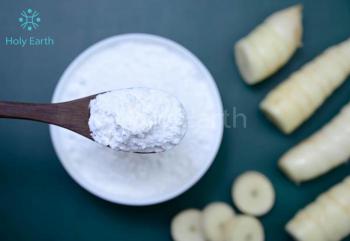
Arrowroot is a good source of essential nutrients like sodium, zinc, potassium, and folate which are important for both the mother and the unborn baby during the time of pregnancy. Folate is essential for skeletal development and is an important component in DNA synthesis and cell division. Folate is important in preventing neural tube defects and other birth defects in growing fetuses. Using arrowroot in diet may also be helpful for women at risk for gestational diabetes. Arrowroot powder is good for digestion and is a good source of folate. Folates are important during pregnancy. Just 100gms of arrowroot can give about µg or 84% of the daily required levels of floats. If a pregnant woman is exposed to a virus or bacteria that can cause pain, it will be quite serious for the baby in the womb. Arrowroot powder has a lot of minerals and protein that can increase body resistance.
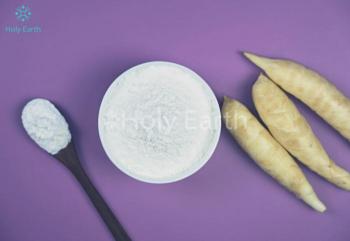
Arrowroot has significant antibacterial properties that can aid in wound healing and act as an antiseptic. It can be used to treat wounds, cuts, and bruises, and infections as well. It quickly absorbs moisture and sweat, which makes it difficult for the microbes to grow and worsen the infection. It also contains zinc that aids to soothe burns and sunburn. In Ayurveda arrowroot is used to treat smallpox, gangrene, Athletes foot, and sunburn. Arrowroot powder is a natural antidote for poison. It can cure septic wounds like snake bites, spiders, or Scorpio bites. It can bring down the pain, itching, and swelling. Applied as a poultice, it can help relieve common insect stings as well. As per Ayurveda, Arrowroot powder is cool in effect (Virya) and sweet in taste (Rasa) which has the natural potency to pacify Pitta and Vata dosha. The natural cooling traits of arrowroot powder support to soothe irritation and inflammation. Arrowroot powder can be mixed with water to form a paste and can be applied to cuts, bruises, and scrapes.
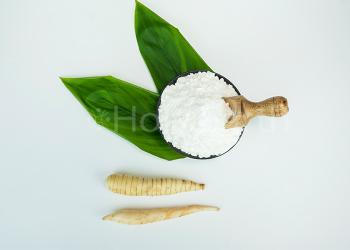
Arrowroot powder is a starch that is very high in carbs. About 80% of the calories in arrowroot are due to carbs. Arrowroot is naturally gluten-free, grain-free, vegan, and paleo-friendly. It is a probiotic starchy food that is high in dietary fiber and has a good response to the immune system. It is extremely high in carbohydrates and is devoid of nutrients well as anti-nutrients such as gluten and phytates. A 1-cup (120-gram) serving of sliced, raw arrowroot contains the following:
Calories: 78
Carbs: 16 grams
Protein: 5 grams
Fiber: 2 grams
Fat: 0 grams
Phosphorus: 17% of the DV
Iron: 15% of the DV
Folate: 102% of the Daily Value (DV)
Potassium: 11% of the DV
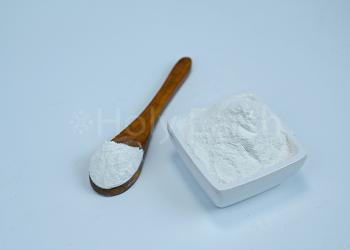
Arrowroot is used as a remedy for various skin problems. Nutrients like potassium, sodium, and zinc in arrowroot improve blood flow, thus producing healthy and glowing skin. It can be used to get rid of skin pigmentation, acne and can even delay premature aging. The vitamins and minerals in arrowroot improve the texture of the skin and It can be used in facial masks where it helps in the absorption of nutrients by the skin to make it soft and glowy. It can also be used as a thickening agent in skincare products. Because arrowroot is rich in minerals and vitamins such as iron and Vitamin B6, it can provide relief to skin irritations including rashes, acne, skin, and sores. It dries out blemishes and rashes and provides a silkier smoother skin tone. As per Ayurveda, Arrowroot powder is cool in effect (Virya) and sweet in taste (Rasa). The natural cooling traits of arrowroot powder support to soothe irritation and inflammation. Topical application of arrowroot powder can improve one's skin texture, reduce oiliness and bring a natural glow to one's complexion. It has antiseptic and antibacterial properties. It can be used to treat wounds, cuts, and bruises, and infections as well. It quickly absorbs moisture and sweat, which makes it difficult for the microbes to grow and worsen the infection.

Arrowroot powder is a great absorbent and can be used as a dry shampoo to fix greasy and oily hairs. Plenty of natural brands already use arrowroot powder in their dry shampoo formulas. A mixture of cocoa powder and arrowroot creates the perfect DIY dry shampoo recipe. The main idea behind these DIY Dry Shampoo is to use arrowroot powder as an oil-absorbing substance on the oily parts of your hair. Arrowroot will absorb the oil from the scalp giving you a clean and volumized look. It doesn’t matter if you’re a brunet or a blond, have ginger curls or colored straight hair, you can make your own perfect mix of DIY Dry Shampoo Using Arrowroot. It is safe for hair, absorbs excess oil which is great if you have oily hair.
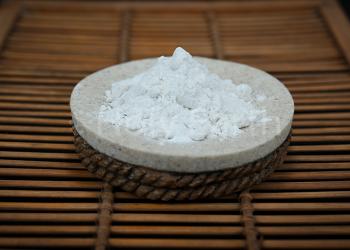
Arrowroot has antiseptic and antibacterial properties that can stop the spreading of any infection to relieve pain. It can be used to treat wounds, cuts, and bruises. It quickly absorbs moisture and sweat, which makes it difficult for the microbes to grow and worsen the infection. As per Ayurveda, Arrowroot powder is cool in effect (Virya) and sweet in taste (Rasa) which has the natural potency to pacify Pitta and Vata dosha. The natural cooling traits of arrowroot powder support to soothe irritation and inflammation. In addition to thwarting toxins and infection, it also has the potential to absorb excessive oil secretion.

Information on the nutritional value of arrowroot flour indicates that it is a paleo food. Arrowroot is simply a white, powdery starch that's naturally gluten-free, grain-free, vegan, and paleo-friendly. It is a probiotic starchy food that is high in dietary fiber and has a good response to the immune system. It is extremely high in carbohydrates and is devoid of nutrients well as anti-nutrients such as gluten and phytates. It can be used in conjunction with almond flour or coconut flour to make Paleo baked goods light and fluffy. Because arrowroot is high in carbs and relatively devoid of nutrients, treats made with it can provide a great carb boost.
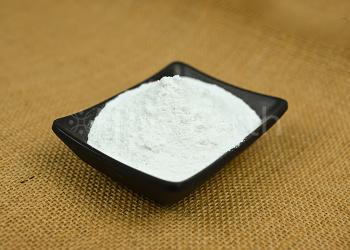
Arrowroot powder is a starchy powder that has antibacterial properties. Magnesium in arrowroot absorbs moisture and minimizes odors. As an antiperspirant, it absorbs additional moisture and keeps you afresh. That’s why it is one of the key ingredients of Aluminum-free deodorants, or more popularly known as “natural deodorants”. The idea is to neutralize odor by stopping perspiration and, in some cases, help absorb the wetness. As the name suggests, Natural deodorants are created using natural and recognizable products such as arrowroot, baking soda, and of course, essential oils. Arrowroot is an excellent antiperspirant and switching to arrowroot, users have not experienced any problems that could further upset sensitive skin. After gradual use users have claimed they’re not sweating as much as you used to. And on top of that, any dark patches on your underarms have gradually started to lighten up and disappear.

Yes, As, arrowroot works great with monster absorption and thus are popularly been used as deodorants. Arrowroot is rich in starch and mainly used as a thickener in deodorant, but because of its antibacterial property, it can remove toxins and impurities. Magnesium in arrowroot absorbs moisture and minimizes odors. Hence it can be used as a natural deodorant. It is extremely soothing and allergy-free hence very suitable for sensitive areas such as underarms. As a starch, it absorbs some of the moisture that gets trapped on the skin thus keeping you afresh. That’s why it is one of the key ingredients of Aluminum-free deodorants, or more popularly known as “natural deodorants”. The idea is to neutralize odor by stopping perspiration and, in some cases, help absorb the wetness. As the name suggests, Natural deodorants are created using natural and recognizable products such as arrowroot, baking soda, and of course, essential oils.

Arrowroot is starchy and is white in color. Just like corn starch, it has thickening abilities. In raw form, it is ivory to white in color and is firm, dense, and smooth in touch, and juicy in taste with a mild, sweet flavor. Arrowroot powder has a neutral taste and no pronounced flavor. So it adds consistency without interfering with the flavor of the dish. Arrowroot powder is 100% gluten-free thus is a great substitute if you’re looking to avoid cornstarch, potatoes, etc. As a thickening agent, It is perfect for dishes that have delicate flavors.
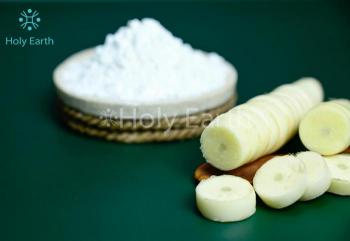
Arrowroot is a starchy substance. It is the root of the tropical plant called Maranta arundinacea. It is a large perennial herb that may vary in length from 3 to 6 feet with large-sized stems and turmeric-like broad ovate leaves. Flowers are tiny, white in color, and appear all along the long pedicle about 90 days after planting. Arrowroot leaves are called lanceolate. The root is underground and is about 10 inches long, weighing about 30 to 50 g. The root is a small, cylindrical-shaped, cream-white/light red tuber, covered with thin surface scales similar to cassava and yucca or kudzu which are oblong in shape. The root parts of the plant are typically called arrowroot and are edible. It is mostly starchy and can be used rather like a potato. It is a cream-white cylindrical-shaped tuber and carries a resemblance to a large potato covered with thin surface scales. Just like corn starch, it has thickening abilities. In raw form, it is ivory to white in color and is firm, dense, and smooth in touch, and juicy in taste with a mild, sweet flavor. However, the leaves and stalks of the plant can also be chopped up and used as surface mulch around the garden. The artwork will utilize it to help cycle minerals deep into the soil.

Arrowroot powder is a natural antidote for poison. Arrowroot powder can even help with snake bites and certain spider bites. It can bring down the pain, itching, and swelling. Applied as a poultice, it can help relieve common insect stings as well. Traditionally, it has been used as an antidote for poison in many parts of the world. Ancient Indonesian and Amerindian cultures treated scorpion venom and poison arrow wounds with Arrowroot powder. In some regions of the world, the grounded rhizome is used as a remedy for vegetable poisons. It serves as a great antidote to toxins. It is also found to be effective against scorpion venom and a spider bite. As per Ayurveda, Arrowroot powder is cool in effect (Virya) and sweet in taste (Rasa) which has the natural potency to pacify Pitta and Vata dosha. The topical application of arrowroot paste is the Ayurveda remedy for insects and mosquito bites. Additionally, it offers the body nourishment, strength, and maintains electrolyte balance.